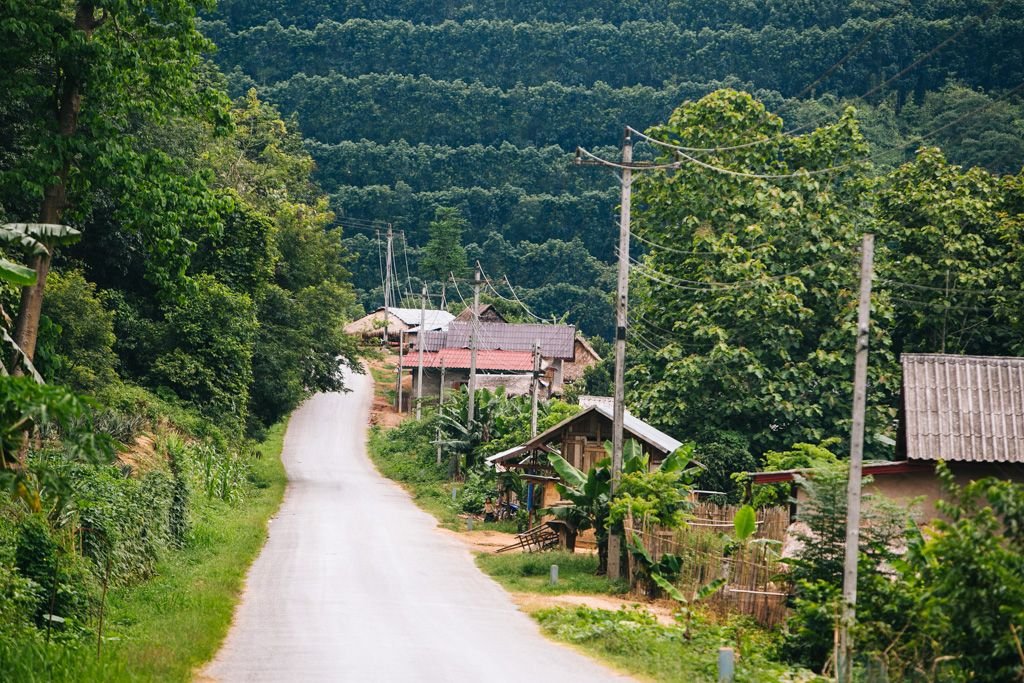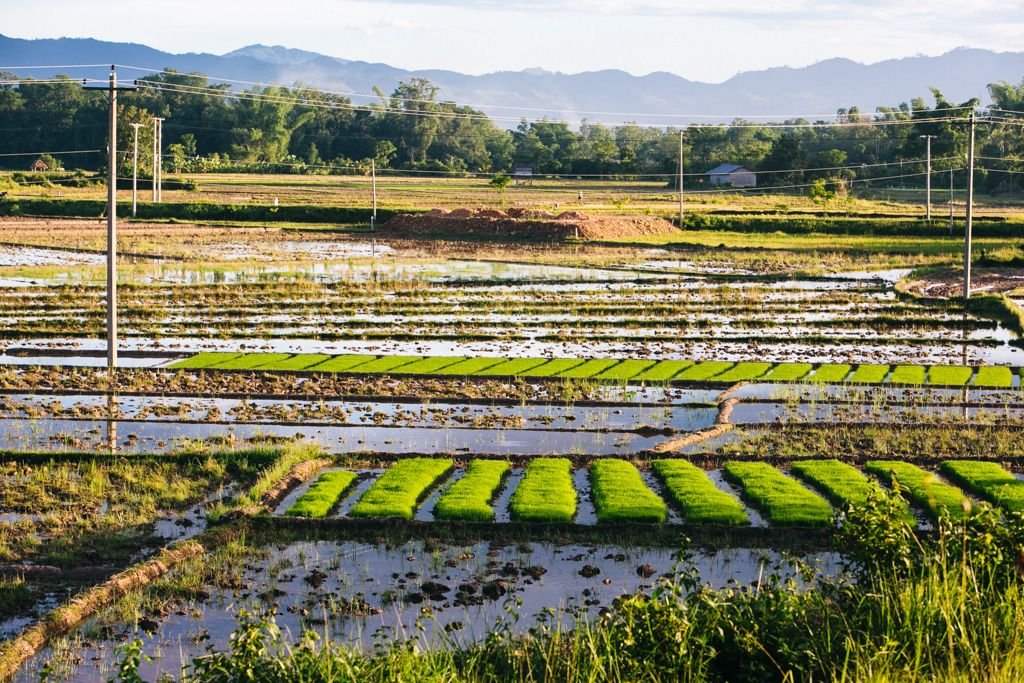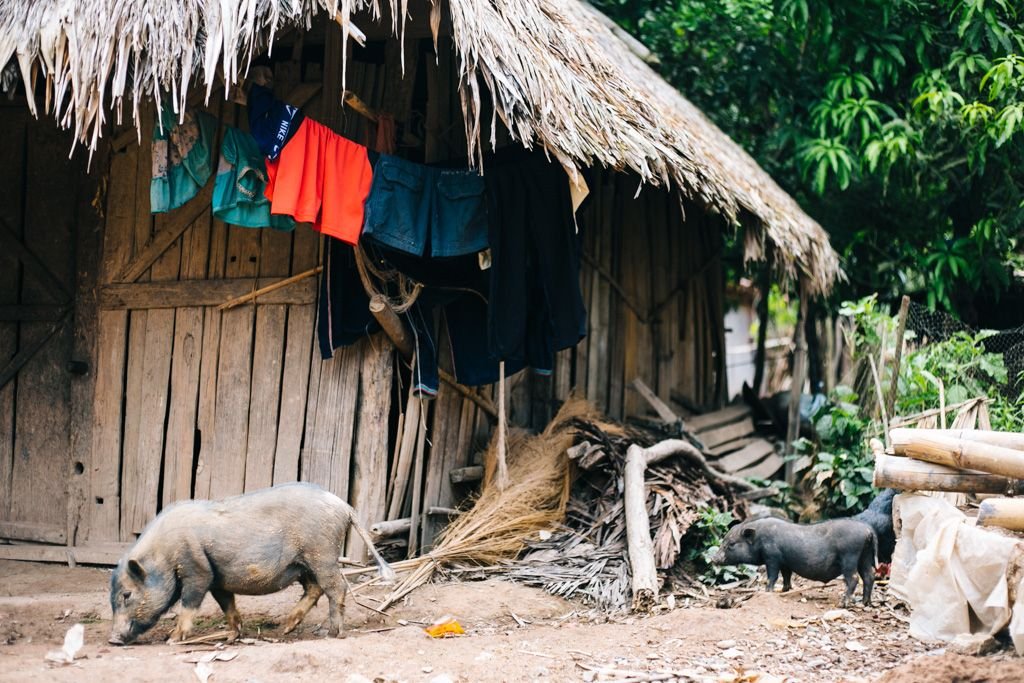This post was last updated on 2024 April 21
Crammed in the back of a local minivan in a sea of Lao people, I dozed in and out of sleep while we crawled from the Thai/Lao border to Luang Namtha. Every so often I’d wake up, look out the window, and think to myself HOLY CRAP LAOS IS GORGEOUS! We were traversing an endlessly winding road that would often turn a corner to reveal mountainous view after mountainous view. I couldn’t wait to get out there and be *in it*.
After about 4.5 bumpy hours, we arrived in Luang Namtha, where I’d laid out 3 tasks for myself: village visits, cycling, and trekking.
Villages in Luang Namtha
Luang Namtha is primarily utilized as a stopover spot on the backpacker trail from China to Laos; however, to me the main allure of Luang Namtha was how accessible the local villages are. There is one main road that runs through town with a number of dirt roads that skirt off of it, many of which lead to villages. I asked for a map when I rented my bike, which handily pointed out exactly where to find these spots. You can reach some villages on foot with a whole lot of walking, but it’s much more efficient to bike to them.
I was a little apprehensive about traipsing through villages where I clearly did not belong, but the locals were nothing but friendly and curious about me. I was careful not to intrude, but I had adults waving at me and children swarming me in no time. These girls kept posing for my camera without my even asking, and after each shot they would run to me to see what the picture looked like on the LCD screen. So adorable!
Cycling around Luang Namtha
Cycling in Laos was a top priority for me. I wanted to ride through the countryside and past mountains and soak up the scenery on my own terms (i.e. not while trapped inside a crowded minivan).
Laos is very hilly and the roads are not well kept, so if you’re cycling you’ll want to hire a mountain bike with gears. Attempting it with a cruiser or road bike is a suicide mission.
I took the main road north out of town and followed it indefinitely. It felt like I was going downhill an awful lot, which made me dread all the uphill action coming back. But I couldn’t stop! Each hill and bend tempted me further. The thrill of speeding downhill and coasting back uphill gave me high after high – until it started to downpour. Hello, Southeast Asian wet season!
The scenery was totally worth getting soaked for. Hills, trees, villages, valleys, rivers – just so much GREEN. I couldn’t get enough. And somehow, the ride back was nowhere near as arduous as I’d suspected. The downhills gave me enough speed to get up most of the uphill parts at least part of the way!
Kayaking Trip in Nam Ha NPA
Luang Namtha is the launching point for excursions into Nam Ha National Protected Area (NPA). There are numerous competing tourist offices around town that offer all sorts of trips into the forest, from single to multi-day treks, kayaking trips, and village homestays – or a combination of these. It’s important to note that quality varies wildly between companies, so be sure to do appropriate research before you book! I had wanted to do a multi-day combo trip so I could experience both trekking AND kayaking through the forest.
But here’s the thing: all throughout Laos, the price of your excursion or activity is dependent on the number of people that sign up for it. Being low season and traveling solo, this meant I was at the mercy of other groups. All of the tourist offices have chalk boards outside that list any outgoing trips, so once you see a trip you like you can join in and pay less for it. I scoured these boards for 2 days and not much was going out. I ended up recruiting a Dutch couple and we compromised on a kayaking daytrip through Forest Retreat Laos.
We took 2 double kayaks out on the river: the Dutch couple in one, and me and our guide in the other. I’d never gone in an inflatable kayak before, but it was pretty easy to maneuver! (I think that had more to do with the fact that I had a certified guide steering, but hey!). We paddled through Nam Ha and were hit with constant blue and green backdrops. At some sections of the river we let the current carry us as far as it could, which allowed us to rest a bit before continuing the paddle.
We made a few stops along the way: first for lunch, where we sat by the river and had veggies and rice wrapped in bamboo leaf. Among its many other uses, bamboo serves as the Lao/Thai version of tupperware. Could they be anymore resourceful?
We also stopped at a couple of villages along the river, but few villagers were around due to it being midday, hot, and sporadically rainy. The pigs and roosters were out and about as usual though, waddling in and out of the houses just as the people do. We were able to catch one woman crafting tassels, which are worn around the neck to jazz up one’s outfit.
Our guide then escorted us inside one of the huts, where we joined some villagers who were sitting in a circle around some candles on what appeared to be an altar. We observed for awhile and watched them tying strings around each others’ wrists, not privy to exactly what ritual we were witnessing. Our guide later informed us that one of the villagers had encountered a snake while sleeping last night, and this ceremony was being conducted to ward off evil spirits (snakes being a bad omen and all). We were all invited to tie a string around his wrist as well.
After the string tying concluded, all the men passed around a shot glass of whiskey and took turns drinking from it. After the 3 of us had repeatedly rejected their offers, we finally gave in and took a sip to appease them. OH MY GOD LAO WHISKEY IS SO STRONG! This was my first taste of Lao Lao – I’m not sure if drinking it straight-up was the way to go. But then they brought out a lunch of sticky rice and 2 different soups, which quickly washed away the aftertaste.
Here’s what’s so nuts: This village ritual experience was totally spontaneous and only happened due to fortuitous timing and hospitable locals. Inviting random passers-by to a special social gathering is unheard of in America, but in Laos and elsewhere in Asia it’s a common occurrence. I feel super lucky to have experienced a local custom in Lao. In fact, visiting the villages around Luang Namtha was one of the best experiences I had on my entire 2013 Asia trip.

Frugal Facts
As of June 2013 —
The local bus from Huay Xai to Luang Namtha takes about 4 hours and costs 60,000 kip ($7.50 US).
A single room at Zuela Guesthouse costs 60,000 kip ($7.50 US) per night; I had bargained them down from 80,000 kip.
Bike rental for a day costs 10,000 kip ($1.25 US). You can rent bikes from most guesthouses or the tourist offices.
I paid 350,000 kip ($45 US) for a kayaking daytrip through Forest Retreat Laos. Pricing for any activity depends on the number of people who sign up; there were 3 people on my trip.




















